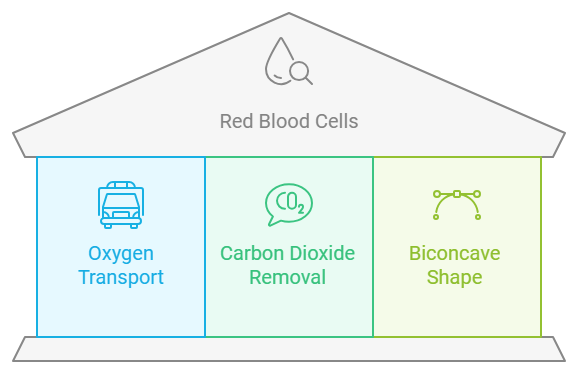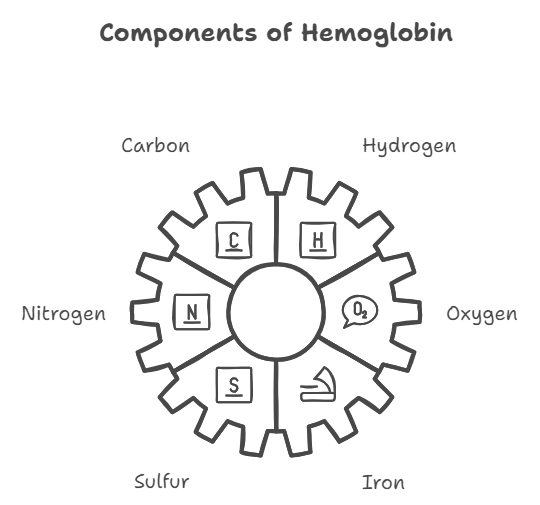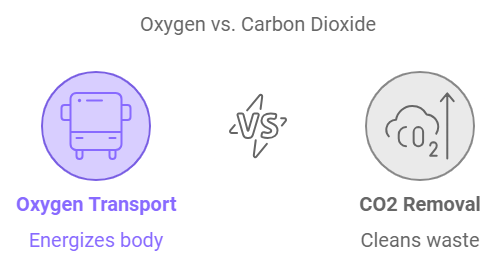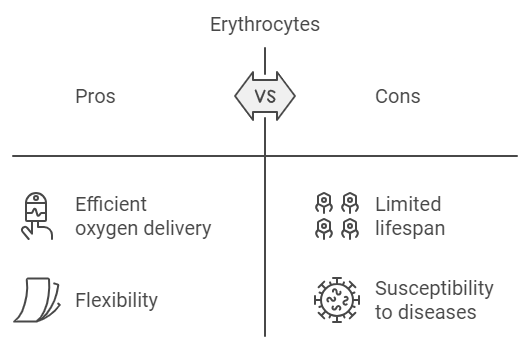Erythrocytes: Erythrocytes, also known as red blood cells (RBCs), are an essential part of your blood. These cells are responsible for carrying oxygen from your lungs to the rest of your body and returning carbon dioxide back to your lungs to be exhaled. Red blood cells have a unique shape—like small, flexible discs with a dip in the middle, called a biconcave shape. This shape helps them move easily through the blood vessels.
In this post; we’ll explore how “erythrocytes” are formed?, their chemical structure, and why they are so important for humans and nature. We’ll also touch on the advantages and disadvantages of erythrocytes and their crucial role in our lives.

How Are Erythrocytes Formed?
Erythrocytes are produced in your body through a process called erythropoiesis. This process happens in the bone marrow, which is the soft tissue found inside your bones. The steps of erythropoiesis are as follows:
- Stem cells in the bone marrow, called hematopoietic stem cells, become immature red blood cells.
- These immature cells undergo changes, such as losing their nucleus (the part of the cell that holds the DNA), which gives red blood cells their unique shape.
- Finally, the mature red blood cells are released into the bloodstream to perform their function of carrying oxygen.
In simpler terms, red blood cells are like oxygen delivery trucks that are made in your bone marrow and travel throughout your body to keep your organs functioning properly.
Can Erythrocytes Be Made in the Laboratory?
While erythrocytes are naturally produced in the body, scientists have been working on ways to create them in the laboratory. This research is still developing, but it’s an exciting area of study, especially for blood transfusions.
The general process of making erythrocytes in the lab includes:
- Using stem cells (similar to the process in the bone marrow)
- Providing the right environment (such as the right nutrients and conditions)
- Growing the cells and helping them mature into red blood cells
The goal is to eventually create red blood cells that can be used in medical treatments, especially for patients who need blood transfusions but have rare blood types.
Chemical Composition of Erythrocytes
Erythrocytes don’t have a chemical formula like a simple molecule would, because they are complex cells. However, the most important component of a red blood cell is a protein called hemoglobin. Hemoglobin is responsible for binding oxygen and carrying it through the blood. The chemical formula of hemoglobin is C₂₉₅₂H₄₆₄₄N₈₁₂O₈₃₂S₈Fe₄;
which shows it contains
- carbon (C)
- hydrogen (H)
- nitrogen (N)
- oxygen (O)
- sulfur (S)
- iron (Fe).

Key Points:
- Erythrocytes are cells made up of different proteins and molecules.
- The main component is hemoglobin, which carries oxygen.
- Hemoglobin contains iron, which is why your blood is red.
Why Are Erythrocytes Important?
Erythrocytes play a crucial role in your body. Without them, your organs wouldn’t get enough oxygen, and you wouldn’t be able to function properly. Here’s why they are so important;

- Oxygen Transport: Erythrocytes carry oxygen from your lungs to every part of your body, ensuring that your organs and tissues can produce energy.
- Carbon Dioxide Removal: After delivering oxygen, erythrocytes pick up carbon dioxide (a waste product) from your cells and transport it back to the lungs for you to exhale.
- Maintaining pH Balance: By controlling the amount of carbon dioxide in the blood, erythrocytes help keep your blood’s pH level balanced.
Advantages of Erythrocytes
- Efficient Oxygen Delivery: Erythrocytes have a high surface area due to their biconcave shape, which helps them carry large amounts of oxygen.
- Flexible and Small: Their small size and flexibility allow them to squeeze through even the tiniest blood vessels, ensuring oxygen reaches every part of the body.
- Long Lifespan: Erythrocytes last about 120 days in the bloodstream, making them efficient for long-term oxygen transport.
Disadvantages of Erythrocytes
- Limited Lifespan: After about 120 days, erythrocytes die and are broken down in the spleen. The body must constantly produce new erythrocytes to replace the old ones.
- Anemia: If your body doesn’t produce enough erythrocytes or if they are destroyed too quickly, you may develop anemia, a condition where you don’t have enough red blood cells, leading to fatigue and weakness.
- Diseases Affecting Erythrocytes: Disorders like sickle cell disease can affect the shape and function of erythrocytes, leading to health problems.
Importance of Erythrocytes for Humans and Nature
For humans, erythrocytes are essential for survival. Without red blood cells, your body wouldn’t receive the oxygen it needs to function. They are also important in:
- Exercise and Activity: Erythrocytes allow you to engage in physical activity by delivering more oxygen to muscles during exercise.
- Immune System Function: They play a role in keeping tissues healthy, which supports your overall immune function.
In nature, erythrocytes are equally important for animals that rely on oxygen-based respiration. They ensure that oxygen reaches all parts of the body in organisms ranging from birds to mammals.
Key Points:
- Red blood cells are vital for human life and animal survival.
- They allow us to breathe and move, making daily activities possible.
- Without erythrocytes, the body would not be able to sustain life.
Advantages of Red Blood Cells in Nature
- Wide Adaptability: Different animals have evolved red blood cells that function efficiently in a variety of environments, from the high altitudes of birds to the deep oceans where marine mammals live.
- Oxygen Efficiency: Red blood cells are incredibly efficient at delivering oxygen, even in harsh environments.
Disadvantages of Red Blood Cells in Nature
- Susceptibility to Diseases: Just like in humans, diseases that affect erythrocytes, such as parasites or infections, can severely impact animals’ health.
- Limited Oxygen Carrying Capacity: When an animal or human is exposed to environments with low oxygen levels (like high altitudes), red blood cells may struggle to deliver enough oxygen, leading to altitude sickness.
Summary of Key Points

- Erythrocytes are circulating red blood cells mainly designed to transport oxygen throughout the tissues and to collect carbon dioxide to be removed from the body.
- They are formed in the bone tissue through formation of erythrocytes.
- Most concentrated within the erythrocytes is hemoglobin – a composition featuring iron atoms that turn the blood red.
- Some advantages include effective transport of oxygen as well as lability.
- Some disadvantages include short life span and exposure to conditions such as anemia.
- Red blood cells are essential for life to them and for the biosphere.
Conclusion
Blood is composed of different types of cells which can mainly be classified as erythrocytes or red blood cells. Red cells have the job of repair blood tissue, carry oxygen, remove undue gas and keep the body in a normal condition electrically. Without them, the life which is currently existent would be unachievable. From the peculiar shape in which they are made in the bone marrow to their contribution towards the restoration of health and wholeness, the red cells are a wonder of biology.
FAQs
The main function of erythrocytes is to carry oxygen from the lungs to the rest of the body and return carbon dioxide to the lungs for exhalation.
Hemoglobin is the protein in erythrocytes that binds to oxygen and helps transport it through the bloodstream.
Yes, scientists are working on creating erythrocytes in the lab using stem cells, but it’s still an area of research.
If you don’t have enough erythrocytes, you may develop anemia, which can cause fatigue, weakness, and other health issues.
Red blood cells are red because of the iron in hemoglobin, which binds to oxygen and gives the blood its red color.
- How Are Erythrocytes Formed?
- Can Erythrocytes Be Made in the Laboratory?
- Chemical Composition of Erythrocytes
- Why Are Erythrocytes Important?
- Advantages of Erythrocytes
- Disadvantages of Erythrocytes
- Importance of Erythrocytes for Humans and Nature
- Advantages of Red Blood Cells in Nature
- Disadvantages of Red Blood Cells in Nature
- Summary of Key Points
Examdays Article Agenda
- 1 How Are Erythrocytes Formed?
- 2 Can Erythrocytes Be Made in the Laboratory?
- 3 Chemical Composition of Erythrocytes
- 4 Why Are Erythrocytes Important?
- 5 Advantages of Erythrocytes
- 6 Disadvantages of Erythrocytes
- 7 Importance of Erythrocytes for Humans and Nature
- 8 Advantages of Red Blood Cells in Nature
- 9 Disadvantages of Red Blood Cells in Nature
- 10 Summary of Key Points
